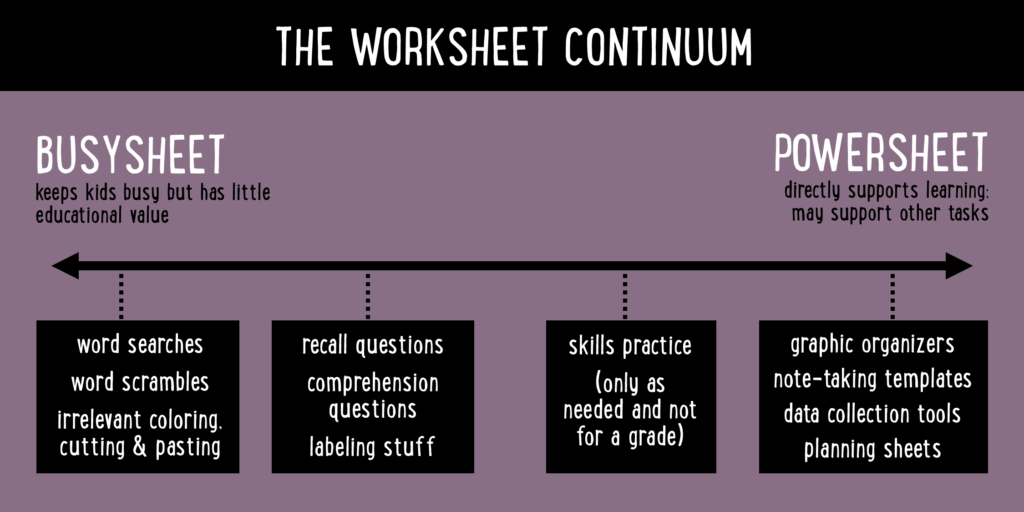
Image via Cult of Pedagogy
As auditors, one of our jobs is to analyze and evaluate student work artifacts: the actual assignments students are given to do in their classrooms. We look at these to see if they correspond the curricular objectives, and to evaluate the level of cognitive demand they require. In other words, how much and how complexly does a student have to think to complete the task? We also look at another critical component: context. Context is the “how” of the task. The “how” is important because some contexts are more cognitively engaging than others: they draw kids in and spark interest, enthusiasm, and curiosity.
Here’s a brief example of how context affects engagement: Two 4th grade classrooms in two different schools in the same district. Both are studying soil types. Classroom A is given a minimally illustrated 2-page article about soil types and told to take notes in the margin about the various characteristics of the soils. They are also told to underline information they think will be important to know. Classroom B arrives to find 4 cylinders and 4 baggies of soil at each workstation. Working in groups, their task is to fill the cylinders with the different types of soil and pour water through each. They must then record their observations on a provided sheet. After that, they must explain what the water test demonstrated about each soil type and why they think this is so. Which one would you rather participate in? Which one will be easiest to remember?
We see a lot of worksheets. In fact, it would be fair to say that a high proportion of the artifacts we look at are worksheets of one kind or another. It’s important to state here that not all worksheets are bad. However, like anything worth doing, constructing a good worksheet that promotes critical thinking takes care and skill. And a lot of worksheets out there do not show much evidence of either care or skill.
In recent years, there has been a proliferation of worksheets on the internet – items that teachers can download for free or for a small fee and then photocopy to their heart’s content. This happens frequently when a district doesn’t have a specific written curriculum with easy to access and interpret guides and objectives linked to external assessments. Unfortunately, many of these free “tools” come with spelling and grammatical errors, or errors in content. And many of them are very low in cognitive demand.
Still other worksheets fall into an entirely separate category: sheets designed to keep kids quiet and in their seats. Sometimes students are given thick packets of these sheets – “Homework Packets,” “Study Packets,” etc. These are usually filled with very low level tasks and Time Killers: word searches, coloring pages, break-the-code activities, and so on. We see packets like these all the way through high school. Kids learn to dread these packets. They are typically not very engaging. Or, perhaps more accurately, some of the activities were engaging once or twice, but having encountered them in myriad classrooms for many years they no longer spark any interest or excitement. And certainly no cognitive engagement. They are rote learning, basic comprehension, and irrelevant activity.
The Cult of Pedagogy Podcast recently explored this topic in a fascinating episode called Frickin’ Packets. The title comes from a viral video of a young man in a high school classroom who is delivering a masterful critique of his teacher after being given yet another homework packet to complete during class. Disrespectful? Absolutely. Do we condone it? Nope. And yet, his indictment of the system of instruction he’s been subjected to is valid. The episode points out that he is an 18 year old sophomore, so clearly the educational process has not been entirely smooth for him. Rather than using that as a way to dismiss his comments, that fact seems to give them more legitimacy. And his frustration at being denied a more engaging educational experience is very real. What follows in the podcast is a well-thought-out description of the continuum of worksheets, from the Time Killers (Busysheets) to the Thought-Promoters (Powersheets).
It’s worth asking why teachers use so many worksheets. I can’t give a definitive answer, but I suspect it’s because worksheets are readily available and easy to implement while designing and executing thoughtful, hands-on activities takes time, thought, and effort. The hands-on activities themselves are not necessarily hard, but the set up and implementation is more time-intensive than photocopying a worksheet. Also, some teachers are intensely uncomfortable with the kind of creative chaos that often accompanies hands-on learning. And yet, study after study has demonstrated the value of such learning, far above and beyond what can be accomplished through a worksheet.
CMSi offers several services and workshops for administrators and teachers to learn how to assess cognitive demand and engagement and build more of both into classroom work. Student Artifact Analysis is a service which provides analysis of a body of student work artifacts — the actual assignments given to students — for cognitive demand, potential for engagement, and alignment to standards and external tests. It provides invaluable insight into the work of district classrooms. Resource Alignment and Examining Student Work teaches teachers and principals how to evaluate student work artifacts and resources for both alignment to curricular goals and external assessments and the cognitive demand and engagement of those activities and resources in the classroom. Cognitively Complex Instruction gives teachers tools to make classroom activities more cognitively rigorous and more engaging and hands-on for students. We have additional workshops that help teachers promote cognition and engagement for ELL/Dual Language students and Gifted and Talented students. Contact us for more information.
